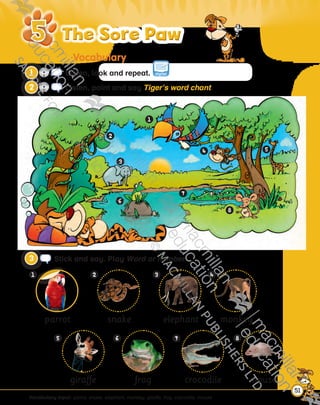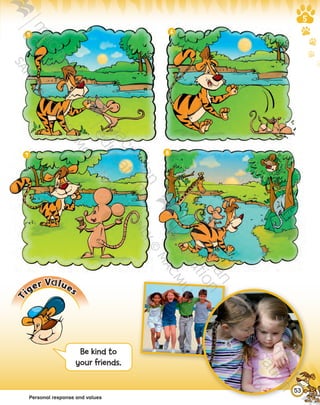tiger
- 1. The Sore PawThe Sore Paw Lesson 1â Vocabulary Vocabulary input:Â parrot, snake, elephant, monkey, giraffe, frog, crocodile, mouse Stick and say. Play Word or number. parrot snake elephant mousefrog crocodilegiraffe monkey 51 CD3 5 Listen, look and repeat. CD3 6 Listen, point and say Tigerâs word chant. video 9780230483569_text.indb 51 07/10/2014 13:18
- 2. Lesson 2â Story STORYTIME Story and language input:Â Iâve got a sore (paw). Can you help me, please? No, sorry. I canât./Yes, of course I can. CD3 7 Listen to the story. Say stop! Answer the questions.video 52 9780230483569_text.indb 52 07/10/2014 13:18
- 3. Personal response and values Be kind to your friends. T iger V lues 53 9780230483569_text.indb 53 07/10/2014 13:18
- 4. Lesson 3â Story activities Story activities CD3 9 Listen and sing Can you help me, please? Number the pictures in order. CD3 8 Listen and say the missing words. Tick (4) the animals in the story. Circle the animal that helps Tiger. 4 1 54 9780230483569_text.indb 54 07/10/2014 13:18
- 5. Lesson â Speaking Pronunciation:Â Iâve got a mouse and a monkey. Communication:Â Iâve got a sore (mouth). Can you help me, please? No, sorry. I canât./Yes, of course I can. mouse monkey Ti ger Phonic s Make the cut-out on page 91. Act out the story. Do a role play. CD3 11 Listen, look and say. O VER TO YO U 55 9780230483569_text.indb 55 07/10/2014 13:18
- 6. CD3 13 Listen and repeat. Answer the questions. HH mm vveeoo ww ooeeww CD3 12 Listen and point. Mime and say. Lesson 5â CLIL Content input:Â how we move: walk, run, climb, jump, swim, fly PING ANDPONG PING ANDPONG 56 9780230483569_text.indb 56 07/10/2014 13:18
- 7. Content and personalisation:Â A (giraffe) can (run). I can (jump). Can you (fly)? Yes, I can./No, I canât. Play A parrot can fly! CD3 14 Listen, number and repeat. CD3 15 Listen and point. Sing A frog can jump. Tick (4) what you can do. Lesson 6â CLIL 4 1 OVER TO YO U 57 9780230483569_text.indb 57 07/10/2014 13:19
- 8. Lesson 7â Unit review CD3 16 Listen, number and repeat. Read, stick and write. 1 monkey monkey 58 9780230483569_text.indb 58 07/10/2014 13:19
- 9. CLASS CHAT Go to the Picture Dictionary on page 82. CD3 17 Listen, circle and repeat. Ask and answer. Match and say. ï ï ï ï ï ï Learning to LEARN Learning to LEARN Learning to LEARN Learning to LEARN Learning to LEARN Learning to LEARN Learning to LEARN 59 9780230483569_text.indb 59 07/10/2014 13:19
- 10. CD3 19 Listen and number. Draw and say. CD3 18 Listen, say and act out a traditional rhyme: Eeny meeny miny moe. Kidsâ Culture 5 Intercultural learning:Â traditional rhyme: Eeny meeny miny moeâ Language input:Â I can see a (mouse). Itâs (brown). COM PARING CULTU RES 60 9780230483569_text.indb 60 07/10/2014 13:19









